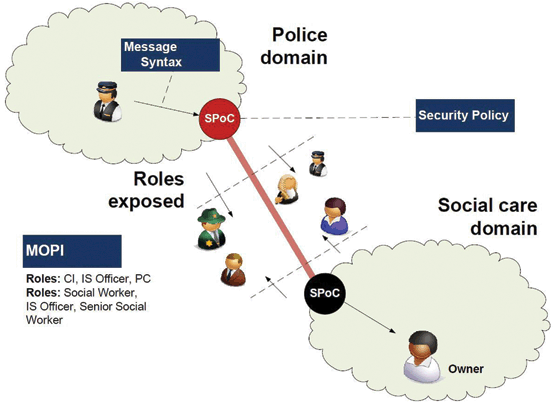Towards Multidimensional Rule Visualizations

Fig. 33.1
a A text is communicated from a sender to a receiver. b A visualization refers to clear and distinct knowledge and hence contributes to understanding
The annual JURIX conferences are among the most important in legal informatics regarding both the content and the form of scientific presentations. The leading projects in the world are presented here. In many cases visualizations make the text easier to understand, at least in terms of key points. On a meta-reflection level, however, the empirical question is how these visualizations are constructed and what types can be found therein. Such an analysis may also affect the future design of visualizations in legal informatics, especially as corresponding design principles are not yet in the canon.
33.2 Types of Multidimensionality in Legal Visualizations
First we explain what we mean by multidimensionality in rule representations.
33.2.1 One-dimensional (1D) Visualization
Traditional norms (rules) are represented linearly: in text, both in natural languages and in artificial languages including mathematical notations, formal logic (propositional logic, predicate logic) and programming languages such as Prolog. A traditional notation is “If A then B”, A → B or N(A/B), read “when a state of affairs A is given, then the legal consequence B applies”. There are other notations such as Polish prefix notation that comprises a deontic modality and was used by Ilmar Tammelo (1978). An example of a Prolog-like notation is the logical legal sentence in Hajime Yoshino’s Logical Jurisprudence (2011).
33.2.2 Two-dimensional (2D) Visualization
Metaphors and symbols can also be employed to represent norms and hence pictorial two-dimensional representations emerge (Röhl and Ulbrich 2007, pp. 42–62). An ancient example is the frontispiece of the book Leviathan by Thomas Hobbes,2 where the state allegory is encapsulated in the sovereign Leviathan that is represented by a giant crowned figure. Besides pictorial visualizations, logical diagrammatical visualizations including info-graphics are widely used to represent legal content such as argumentation graphs, storytelling, legal workflow, etc. (Kahlig 2008).
33.2.3 Two and Half-dimensional (2½D) Visualization
2D diagrams can include pictures of three-dimensional real world bodies such as cubes, cylinders, people, computers, houses, etc. and their icons, producing so-called 2½ representations. The icons of three-dimensional real bodies are used to contrast 2D diagramming elements and abstract concepts.
33.2.4 Three-dimensional Visualization and Films
An example of three-dimensional visualization is the “Menzi Muck timber case—the Film!”,3 which presents situational visualization. The case concerns the liability for damages suffered by a volunteer. This 4-min film takes a familiar case from 2002 (BGE 129 III 181 ff.). The Swiss Federal Court defined demarcation criteria between favour (Gefälligkeit), gratuitous contract (unentgeltlicher Auftrag), agency without specific authorisation (negotiorum gestio, Geschäftsführung ohne Auftrag) and the compensation claim of a volunteer (Schadenersatzanspruch der unentgeltlich helfenden Person).
33.3 Visualization Criteria
We further examine selected pictures from JURIX 20124 papers. This examination is done on the reflexive level of legal informatics. First we discuss systematically different criteria:
Citation. The names of laws and article numbers can be included in diagrams (Winkels and Hoekstra 2012, p. 160).
Colours. In black–white press, dark and light grey tones aid comprehension (Winkels and Hoekstra 2012, pp. 158–166).
Dimensions. Multiple dimensions on the paper can be achieved with 2½D. For instance, a wire-cube representation in Pace and Schapachnik (2012, p. 111) is supplemented with transitions and represents strength diagrams.
Domains. Different problem domains can be referred to (Winkels and Hoekstra 2012, p. 158).
Elements with text. Abbreviations may be difficult for non-experts (Szӧke et al. 2012, p. 150). Similar may be with suspension points; see e.g. (Robaldo et al. 2012, p. 137) and (Szӧke et al. 2012, pp. 150, 152).
Focus. This is represented by bold face and a dark background. Important elements are coloured in dark grey and less important in light grey or white (Szӧke et al. 2012, p. 154). There are also different shapes (angled, rounded).
Mindmapping. Visualizations in the form of mindmapping are creative. An ontology design (Poudyal and Quaresma 2012, p. 118) is shown with no cross-links.
Mixed types. Different types of elements are combined (Szӧke et al. 2012, p. 150). This is good for legal education, but may be not very useful for formal semantics.
Quantity. Too many elements confuse the issue. Therefore layers, levels and subelements are used (Winkels and Hoekstra 2012, p. 158).
Relationships. Various relationships are depicted with different connectors. Different types of arrows are normally used: arced, curved, down, etc. Relationships can have a predefined or a newly defined meaning and are represented with edges in graph-like diagrams. Examples of relationships can be found in argument diagrams and defeat graphs in argumentation-based inference (Prakken 2012, pp. 127–128), dependency relations (Robaldo et al. 2012, pp. 137–139), document generation and versioning (Szӧke et al. 2012, pp. 150–154), relationships between concepts in the tax domain (Winkels and Hoekstra 2012, pp. 158–160).
Tables. They contain much textual information but are not always creative (Pace and Schapachnik 2012, p. 113). Transitions can be added (Ramakrishna et al. 2012, p. 132).
Traditional formal diagrams. Examples are argument diagrams (Lynch et al. 2012, p. 84) and statistical data visualization (Poudyal and Quaresma 2012, p. 118; Winkels and Hoekstra 2012, p. 166). They are clear, look good, but are nothing special.
Vertical and horizontal axes. Placing elements top-down can mean different orders: hierarchy, time axis, etc. Horizontal arrangement from left to right can denote ordering in time. Other meanings can also be defined (Robaldo et al. 2012, pp. 137–139), where both the left arrows and right arrows show the rule-triggering sequence.
33.4 Visualizations in JURIX 2012 Proceedings
Selected JURIX 2012 articles are reviewed below in the order of their appearance in the proceedings, where they are ordered alphabetically.